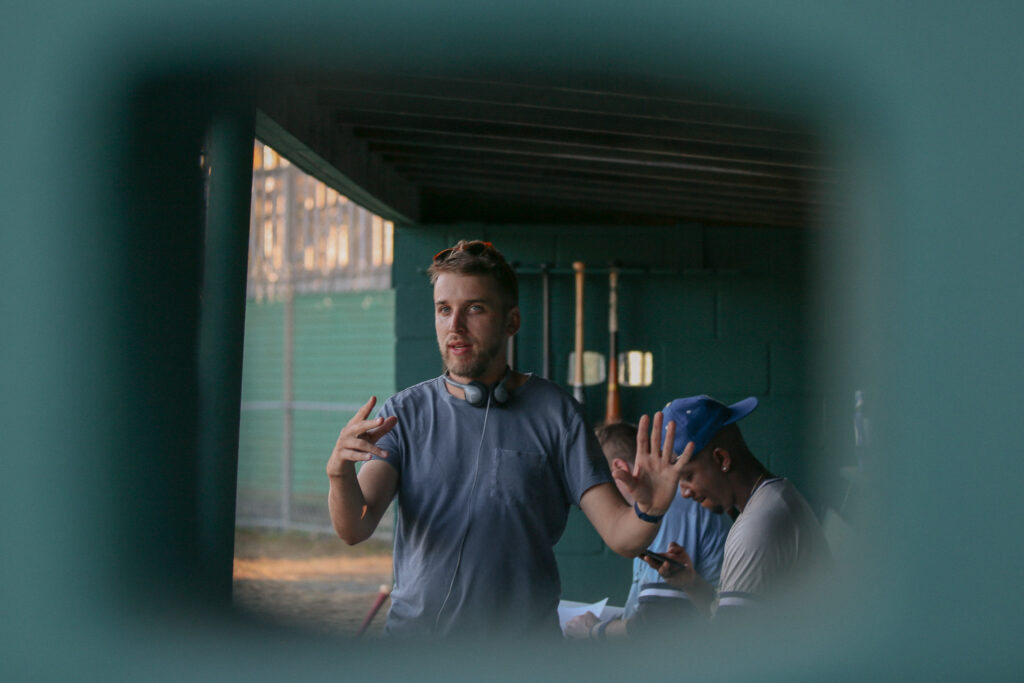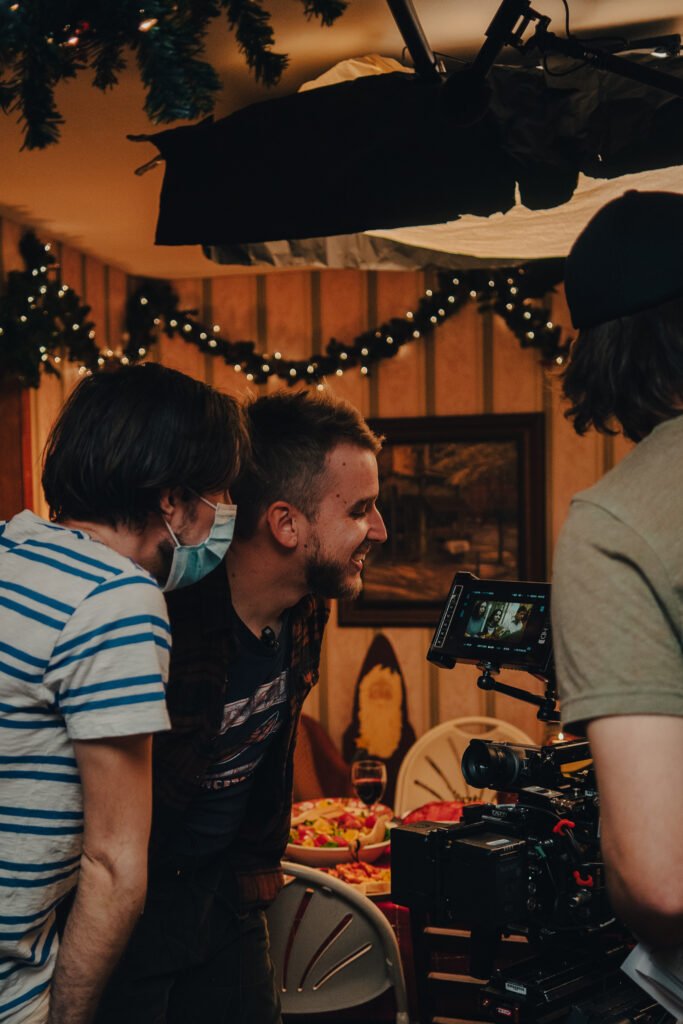Emerson at Cannes: Alum Films Screening at Directors’ Fortnight

Carson Lund ’13 is in a very unique position, as two films he was heavily involved with were selected to show at Cannes Directors’ Fortnight.
Lund directed and co-wrote Eephus, a comedy about a men’s recreational baseball game. Lund also was the cinematographer for Christmas Eve in Miller’s Point, a story co-written and directed by Tyler Taormina ’13, about a family possibly gathering in their ancestral home for the last time.
Cannes Directors’ Fortnight is running from May 15 to 25, and Lund spoke to Emerson Today about his baseball career; working with Emersonians, including Taormina; Ingmar Bergman; cinematography decisions, and more.
How did your Emerson experience help you professionally and/or personally?
Lund: What impacted me most from my time at Emerson were the connections I made, socially and professionally. I still work closely with the friends I made at Emerson, including my frequent collaborators Tyler Taormina, Joe Fiorillo [‘14] and Greg Tango [‘13]. I also remain in touch with certain favorite professors—people like [Visual & Media Arts Professor and Graduate Program Director] John Gianvito, [Visual & Media Arts Associate Professor] Harlan Bosmajian, and [Visual & Media Arts Professor] Shujen Wang—who have helped me along the way in my career at different points.
Having one film at the Cannes Directors’ Fortnight is an impressive achievement. You’ve got two films being screened. How have you balanced working on both films?
Lund: It’s a miracle whenever an independent film is made, and it’s especially miraculous that Tyler and I shot two of our most ambitious features to date within six months of each other. He and I are members of Omnes Films, a collective of independent filmmakers in LA, and Eephus and Christmas Eve in Miller’s Point are our biggest projects yet under the banner, both in terms of budget and cast and crew size.
The timing of the two shoots was surprisingly harmonious. Tyler helped usher Eephus into existence, and once I started shooting the film in Massachusetts in October 2022, he started pre-production on Miller’s Point in Long Island. By the time I finished shooting Eephus and had a few months to wrestle with post-production, production began on Miller’s Point in February 2023.
He and I had been discussing both films together long before we entered production, so I felt well equipped to switch gears and shoot Tyler’s Christmas fantasia. I love the winter holiday season, so it was a world I felt creatively attached to from the beginning.

IMDB’s description of Eephus is that a men’s rec baseball team is playing a game on their favorite field before it’s demolished. Where did the inspiration to write this film come from? How do you personally relate to the characters?
Lund: I’ve always loved baseball, but the actual culture around the sport grew tiring to me by high school. I outgrew the pressure and competition. But I reacquainted myself with the game when I moved to Los Angeles and joined a recreational men’s league. I was struck by the unique relationships I fostered through this weekly extracurricular activity. Now fully into adulthood, I see recreational baseball—and activities like it that are centered around leisure and enjoyment and are not driven by a profit motive—as an essential tool to keep the body and mind active in a time where we’re often so constrained by screens and sedentary labor.
The other inspiration was this lingering feeling I have that this kind of extracurricular community is slowly disappearing, and that so much of the world I grew up in has irrevocably changed. The film is set in the ’90s, before the internet and during a time I personally associate with a lot of outdoor activity in public parks. So I made the movie as a kind of homage to all these things I feel are fading from my everyday life.
What would you say was particularly important to this film when it comes to the directing choices you made? (i.e. did you want to frame characters looking up at them? did you want there to be moments of extreme silence, et cetera?)
Lund: Because of its impending transformation, the landscape of Soldiers Field is highly integral to the drama of this film, so I had to give it the proper emphasis visually and sonically. I chose to shoot mostly in master shots, using close-ups only for pivotal moments of emphasis. The bodies in frame are no more or less important than the environment they are situated in.
We took immense care in the planning of the shoot to ensure we’d be able to preserve lighting and foliage continuity. If the sun was in the wrong spot or the leaves on the trees changed colors erratically for even a moment within the linear timeline of the film, it might disrupt the continuity of time and space, which ultimately would pierce the viewers’ conviction in these characters’ unique circumstances. As a director, my job was to find a delicate balance between the constantly shifting natural world around us and the fictional edifice we were building, and part of that effort involved not cheating with too much editing or close framing.
Do you have a favorite scene from the movie?
Lund: That’s very hard to say. The tone shifts gradually throughout the film from ribald humor to muted melancholy, and there are so many gradations of those two extremes along the way. I think the film really accrues power the longer you immerse yourself in it, so personally I’m very fond of the final act, which is not exactly a scene per se. But hey, come to think of it, the whole film is ultimately one scene. Having seen Eephus so many times myself, I’m more interested in what new viewers find themselves attached to than anything I might be drawn to on a given day.
How’s your eephus pitch? Do you/did you play baseball?
Lund: I played baseball throughout my childhood and well into high school. It was my life as a kid. I played in traveling leagues and wanted to make it a career someday. Now I only play once a week in a Sunday league here in Los Angeles. My team used to be very good but now we’ve gotten too old and lose most of our games but still have fun. Which is kind of the premise of Eephus.
I don’t throw an eephus. That’s the thing, it’s like an endangered species. No one throws an eephus anymore!
Oftentimes sports movies suffer when actors don’t look natural swinging a bat, shooting a jump shot, or running. How important was it to have actors look like they play baseball?
Lund: At first, I was very concerned with verisimilitude regarding athletic performance. I was careful to ask everyone I auditioned about their experiences playing baseball, both historically and in the recent past. The hope was to make a film about men that are not necessarily outstanding baseball players, but who nonetheless value the game enough to show a deep-seated understanding of its rules and a physical ease that gives the implication of second nature behavior.
As my casting process migrated from Zoom auditions to on-field practices, I had to shift my expectations. What I realized was that Eephus would be more powerful if there were a wide range of skill levels on display, from hardened former greats to physically awkward novices who are just there for the camaraderie. These variations only added more color to the ensemble and allowed this to be a film about something more universal than baseball prowess. It’s a film about small town baseball, and in such leagues, you get what you get. All that said, I still did my best to whip this cast into shape on the field!

As the cinematographer of Christmas Eve in Miller’s Point you’re working with fellow Emerson alum Tyler Taormina. When did you two first work with each other, and how has your relationship evolved as collaborators and friends?
Lund: Even though we’d known of each other for years, Tyler and I first worked together on Ham on Rye (2019). Getting to know him in 2016 when we were developing that film was one of the great creative epiphanies of my life. He and I share so much in terms of our views about what cinema is capable of as an art form and what films across the world move us most deeply.
And yet we come from different backgrounds and sensibilities. He’s first and foremost a writer and has a real fondness for Nickelodeon shows from the ’90s. I see myself more as an image maker and had my taste formed by early encounters with Stanley Kubrick and Ingmar Bergman. He’s a real romantic and I can be more of a cynic. But we’ve met in the middle, and now we communicate in creative environments without the need for too many words. It’s almost at the level of my creative relationship with Michael Basta (co-writer, co-producer, and assistant director of Eephus; MassArt alum), though that goes back to childhood.
What unique elements in regards to the look, color, and lighting did you want to incorporate as cinematographer for Christmas Eve in Miller’s Point?
Lund: With Christmas Eve in Miller’s Point, Tyler and I wanted to emulate styles of filmmaking that hark back to the Golden Age of studio movies, when lighting was more expressive than naturalistic, and camerawork showed the mark of a human operator rather than machine control. All of this played into the sense of tradition within the family Christmas party at the center of the film. We gave the image the hazy feel of a memory with the use of anamorphic lenses and diffused filtration, and we also leaned into exaggerated primary colors and shimmering backlights to mimic the idealized mid-century Coca-Cola ads that were such a pictorial influence for Tyler.
What are your goals for attending Cannes Directors’ Fortnight?
Lund: I’m looking forward to an amazing time celebrating the film with the cast and crew who can attend the festival as well as the new sales and PR teams we’ve brought on to support the film’s launch. Cannes is an extremely exciting place to be for cinephiles, and it’s especially exciting to be there when you have a film premiering. We’re hoping to both kickstart the future for Eephus and lay some groundwork for upcoming projects!
Is there anything else you’d like to share about yourself, your Emerson experience, or your career?
Lund: I’d also like to shout out Topology of Sirens (2021), another feature I made with an Emerson alum named Jon Davies ’12. Tyler helped produce this project and I DP’d and edited. It’s a hypnotizing film that not enough people have seen! Currently it’s available to watch on MUBI.
Categories